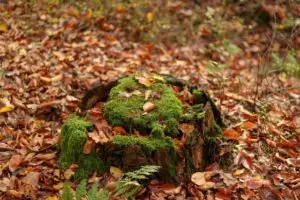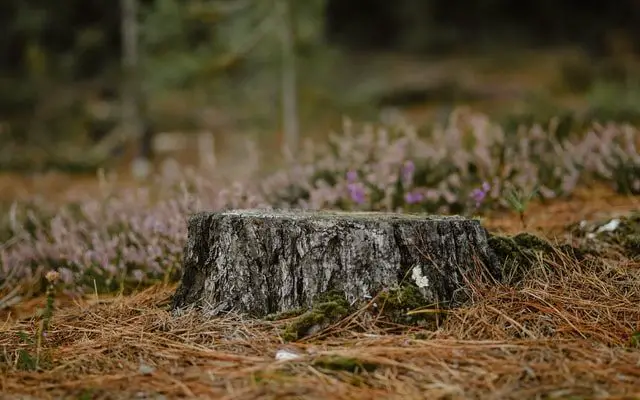How best to remove tree stumps is a question common to many homeowners. Whether it be after cutting down several trees yourself to spruce up the look of your backyard, or having a tree removal service cut down a few trees that were a threat to your roof, getting rid of unwelcome and unsightly tree stumps is a logical next step.
Of course you could pay to have a tree removal service grind the stump, and if you are looking to go with a paid option it is a good idea to discuss the topic of stump removal with the company you are working with ahead of time. Stump cuts, as they’re called, often cost extra, but a good stump cut (cutting down a tree as low to the ground as possible) will make grinding the stump more affordable and will shorten the time it takes for the stump to rot on its own.
However, you need to keep in mind that the cost of stump grinding is extra and that is on top of the already higher cost of the stump cut. In total you could be looking at an additional $100-200 per tree if you decide to pay a tree removal company to solve your tree stump issues.
Some big box home improvement stores will rent stump grinders out to customers. In my area, the average cost is about $250 for a 24 hour rental. You will need a trailer to carry the grinder from the store to your house. Stump grinders can be very dangerous, so make sure you watch safety videos on Youtube before trying this option.
Rotting Tree Stumps Naturally
A more economical idea is to let the stump rot naturally. Left alone, tree stumps will rot in anywhere from 3-7 year depending on what kind of tree you’re dealing with and what kind of climate you live in. Pine trees and trees with softer wood can easily be completely decomposed within that time frame, but harder woods can sometimes take over ten years to rot.
If you are looking to remove the stump before the decade is over, there are several natural methods you can use to speed up mother nature’s work. One of those options is using Epsom salt and the other is using a nitrogen rich fertilize to naturally rot your tree stumps.
Try Copper Nails
There’s some debate on whether this speeds up the death of a tree stump. Some people are convinced hammering copper nails into a tree stump will kill the tree stump more quickly than the natural process. This in turn causes the tree to begin to rot more quickly. The belief is  that the toxicity in the copper will help rot the tree more quickly if the nail penetrates the outer layer of bark.
that the toxicity in the copper will help rot the tree more quickly if the nail penetrates the outer layer of bark.
I’ve never tried this method, but copper nails are easy to find and aren’t very expensive. You can find several different package sizes here (Amazon link).
If you do elect to try the copper nail option, make sure you drill pilot holes. Copper is a softer metal, and depending on the type of tree stump you have, you could end up bending the nail as you hammer it into the wood.
Using Epsom Salts
Using Epsom salt, also known as magnesium sulfate, is perhaps the most common way to naturally rot a tree stump.
Epsom salt is a chemical compound made up of magnesium, sulfur, and oxygen. It is used in a variety of ways including as a relaxation agent, in skin care, and even as a laxative. Epsom salt can also be used to speed up the process of rotting tree stumps.
Here are the steps for rotting out a tree stump with Epsom salt:
- To start, use a large drill bit to drill 4-6 holes in the top of the trunk. The holes should be at least 6 inches deep. I’d recommend a bit that is at least 1/2″ wide. I prefer a 1″ bit and like this particular one from Dewalt (Amazon link).
- Fill each hole with Epsom salt. Be sure to pack each hole with as much Epsom salt as you can.
- Lightly spray the top of the trunk and around the base with water and leave the Epsom salt over night to work its magic.
- For an optional last step you can cover the stump with a tarp or mulch or both.
The Epsom salt will be absorbed into the stump and will work to dehydrate the stump and its roots. This in turn will kill the stump and speed  up the decomposing process.
up the decomposing process.
Note that the Epsom salt will be absorbed into the stump over time. Once that occurs you can repeat the process and repack each hole with Epsom salt.
There are at least two advantages to using Epsom salt to rot your tree stumps. First, is that Epsom salt is very affordable and can be found online or at any garden center. The second is that it is an organic compound and won’t be harmful to the environment.
However, it is important to understand that even if you fill the holes in the stump repeatedly, it will still take a significant amount of time for the stump to rot—anywhere from 2-3 years
Using Fertilizer to Naturally Rot Tree Stumps
The second way to naturally rot a tree stump is by using a nitrogen rich fertilizer. The steps to using fertilizer when rotting your tree stumps are the same as using Epsom salt, only that instead of filling the holes in the top of the stump with Epsom salt, you will fill it with the fertilizer.
Here are the steps again:
- Just like above, use a drill bit that is at least 1/2″ wide and can go 6″ deep. Drill several holes throughout the top of the stump.
- Fill each hole with a nitrogen rich fertilizer. Be sure to pack each hole with as much fertilizer as you can.
- Lightly spray the top of the trunk and around the base with water.
- Cover the stump with a tarp and mulch.
The reason you want a nitrogen rich fertilizer is because the nitrogen will feed the fungi and bacteria that will eat away at the tree stump. It is also a good idea to cover the stump with a tarp if you choose to use fertilizer as it will create a moist atmosphere in which the bacteria will thrive.
The time frame for using fertilizer to naturally rot your tree stump is about the same as it is for Epsom salt—2-3 years.
Fertilizer, however, isn’t as clean an option and you will need to check with environmental regulations in your area before you use it.
Planting Vegetables or Flowers in the Stump
There is one final way to rot your tree stump naturally, and that is by planting vegetables or flowers in bottomless pots on the top of the tree stump. The roots of the vegetables or flowers will grow down into the stump and steal nutrients from it. This will promote the decomposition of the stump, and (slightly) speed up the stump rotting processes.
It is important to note, however, that the vegetable and flower option will take significantly longer than either using Epsom salt or fertilizer. Still, it might be a way to make your unwanted tree stump more functional and ascetically pleasing.
Closing
Tree stumps are an eyesore and it makes sense to want to get rid of any you have in your yard. Hands down the fastest way to get rid of the stumps in your yard is by hiring a tree removal company to come and grind the stumps down. But, this is also the most expensive option and could cost anywhere from $100-200 per stump.
A far cheaper option is to use Epsom salt or a nitrogen rich fertilizer to naturally rot the tree stumps in your yard. Of those two options, Epsom salt is the more environmentally friendly choice and most likely cheaper too. And both Epsom salt and fertilizer will yield similar results, cutting down the time it takes for the stump to rot down to about 2-3 years.
Finally, for those who are in no hurry and want to try to use their tree sumps to improve the look of their yard, you can plant vegetables or flowers in a bottomless pot on top of the stump.
Whatever you choose, you can follow the above steps to help solve your tree stump woes.




